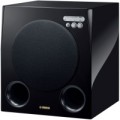Sensitivity
The sensitivity value determines the volume of the subwoofer when an external signal of a certain power is connected to it. The higher the sensitivity, the louder the sound will be, with equal signal power and impedance.
Impedance
Subwoofer AC impedance. This parameter matters primarily when connected to an external amplifier: if the impedance is lower than that of the amplifier, sound distortion is possible, if the impedance is higher, the subwoofer may sound quieter than we would like.
Passive speaker connection
Ability
to connect a passive speaker system directly to the subwoofer.
Only active models equipped with a built-in amplifier have this possibility (see "Type"). Such an amplifier in this case operates over the entire frequency range and is equipped with a crossover that separates the signal into a “bass” and main range. Bass is fed to the subwoofer's own speaker, and the rest of the frequencies are sent to the outputs for connecting passive acoustics. The role of the latter can be played by high-level terminals or Speakon connectors (see below), depending on the class and purpose of the subwoofer.
Anyway, this function allows you to do without an external amplifier for passive speakers, which is sometimes very convenient.
Remote control
A device that allows you to control the functions of the subwoofer from a distance — literally from the comfort of your sofa. Note that, unlike other consumer electronics,
the subwoofer remote control can be wired.
Material
- MDF. Medium-density fiberboard is one of the most popular materials for modern speaker cabinets, including subwoofers. This is due, on the one hand, to the relatively low cost and neat appearance, and on the other hand, to excellent acoustic characteristics.
MDF cases are found in “subs” for all purposes and price categories.
- Tree. Natural wood is well suited for low-frequency acoustic enclosures; its performance characteristics are comparable to MDF described above. At the same time, this material is considered more “natural” and has its own beautiful surface pattern, but is noticeably more expensive. Therefore, although
wooden cases are common, they are not as widespread as MDF.
- Plastic. The main advantage of plastic is its low cost, but it is very difficult to create a body with the necessary acoustic characteristics from this material. Therefore,
plastic subwoofers are extremely rare, mostly built-in models.
- Metal. In this case, we mean various alloys and aluminium models. The metal is highly durable, but the acoustic characteristics are far from optimal. This requires the use of various tricks, which respectively affect the price
of a metal subwoofer. Therefore, this option is quite rare.

